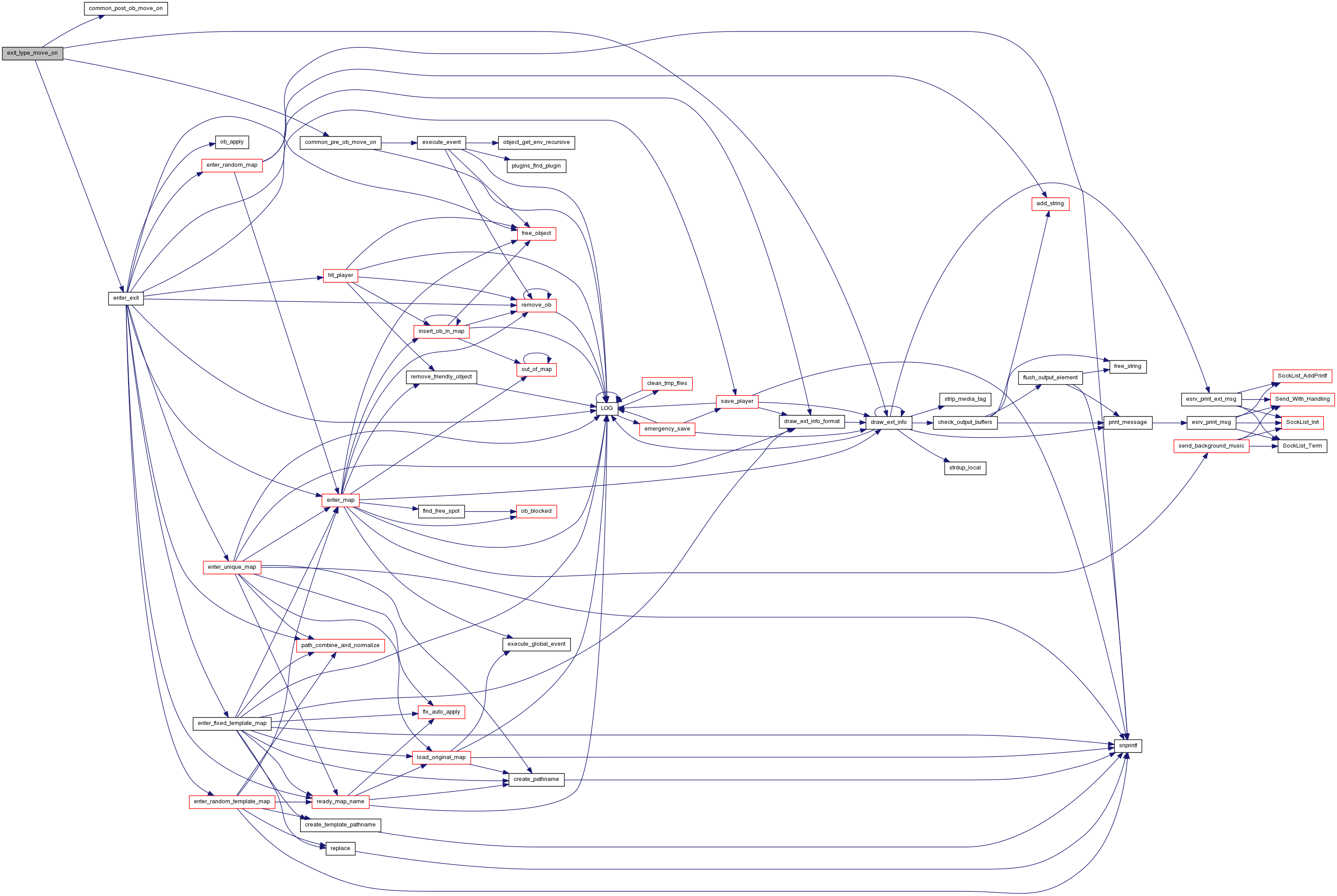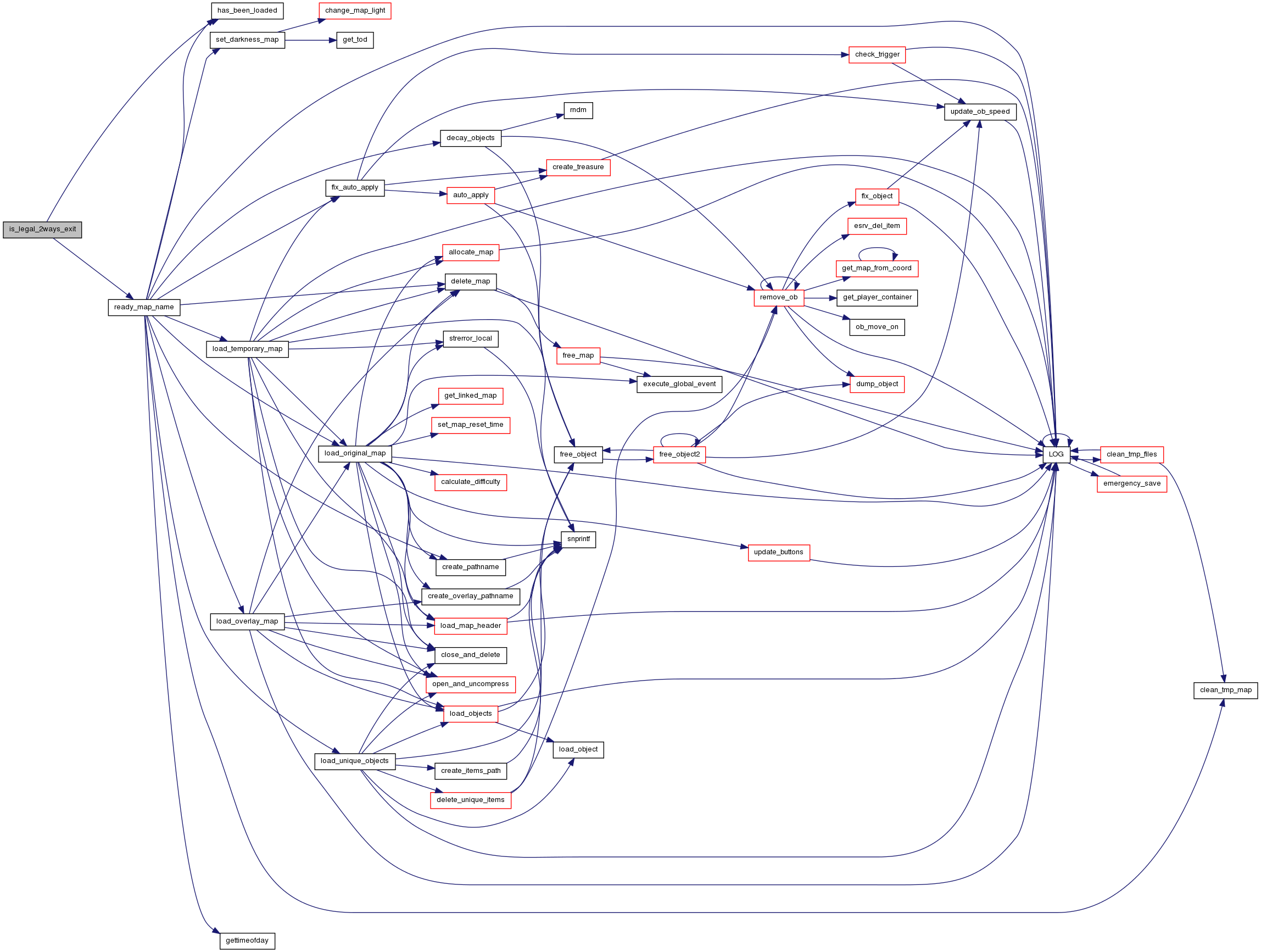The implementation of the Exit class of objects. More...
#include <global.h>#include <ob_methods.h>#include <ob_types.h>#include <sounds.h>#include <sproto.h>
Go to the source code of this file.
Functions | |
| static method_ret | exit_type_apply (ob_methods *context, object *exit, object *op, int autoapply) |
| Handles applying an exit. | |
| static method_ret | exit_type_move_on (ob_methods *context, object *trap, object *victim, object *originator) |
| Move on this Exit object. | |
| void | init_type_exit (void) |
| Initializer for the EXIT object type. | |
| static int | is_legal_2ways_exit (object *op, object *exit) |
| This fonction return true if the exit is not a 2 ways one or it is 2 ways, valid exit. | |
Detailed Description
The implementation of the Exit class of objects.
Definition in file exit.c.
Function Documentation
| static method_ret exit_type_apply | ( | ob_methods * | context, |
| object * | exit, | ||
| object * | op, | ||
| int | autoapply | ||
| ) | [static] |
Handles applying an exit.
- Parameters:
-
context The method context exit The exit applied op The object applying the exit autoapply Set this to 1 to automatically apply the sign
- Returns:
- METHOD_OK unless op is not a player, in which case METHOD_ERROR
Definition at line 160 of file exit.c.
References draw_ext_info(), draw_ext_info_format(), enter_exit(), EXIT_PATH, is_legal_2ways_exit(), MAX_BUF, METHOD_ERROR, METHOD_OK, MSG_TYPE_APPLY, MSG_TYPE_APPLY_FAILURE, MSG_TYPE_APPLY_SUCCESS, NDI_NAVY, NDI_UNIQUE, PLAYER, and query_name().
Referenced by init_type_exit().


| static method_ret exit_type_move_on | ( | ob_methods * | context, |
| object * | trap, | ||
| object * | victim, | ||
| object * | originator | ||
| ) | [static] |
Move on this Exit object.
- Parameters:
-
context The method context trap The Exit we're moving on victim The object moving over this one originator The object that caused the move_on event
- Returns:
- METHOD_OK
Definition at line 52 of file exit.c.
References common_post_ob_move_on(), common_pre_ob_move_on(), draw_ext_info(), enter_exit(), EXIT_PATH, METHOD_ERROR, METHOD_OK, MSG_TYPE_APPLY, MSG_TYPE_APPLY_TRAP, NDI_NAVY, and PLAYER.
Referenced by init_type_exit().


| void init_type_exit | ( | void | ) |
Initializer for the EXIT object type.
Definition at line 39 of file exit.c.
References EXIT, exit_type_apply(), exit_type_move_on(), register_apply(), and register_move_on().
Referenced by register_all_ob_types().


| static int is_legal_2ways_exit | ( | object * | op, |
| object * | exit | ||
| ) | [static] |
This fonction return true if the exit is not a 2 ways one or it is 2 ways, valid exit.
A valid 2 way exit means:
- You can come back (there is another exit at the other side)
- You are
- the owner of the exit
- or in the same party as the owner
- Note:
- a owner in a 2 way exit is saved as the owner's name in the field exit->name cause the field exit->owner doesn't survive in the swapping (in fact the whole exit doesn't survive).
- Parameters:
-
op player to check for. exit exit object.
- Returns:
- 1 if exit is not 2 way, 0 else.
Definition at line 90 of file exit.c.
References EXIT, EXIT_PATH, EXIT_X, EXIT_Y, first_player, GET_MAP_OB, has_been_loaded(), Settings::localdir, MAP_PLAYER_UNIQUE, pl::next, pl::ob, ready_map_name(), and settings.
Referenced by exit_type_apply().


 1.7.6.1
1.7.6.1